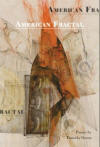American Fractal
Timothy Green’s debut collection of verse, American Fractal, is named for the concept of order existing within what appears to be randomness that mathematician Benoit Mandelbrot developed in fractal geometry. Although his new way of perceiving relationships has revolutionized modern science, initially others were not able to “see” what Mandelbrot discerned and represented in unconventional mathematical formulas. As a poet, Green also challenges readers to see with him the patterns he has discovered and recreated in this aptly named collection of fifty poems in five sections.
Timothy Green’s debut collection of verse, American Fractal, is named for the concept of order existing within what appears to be randomness that mathematician Benoit Mandelbrot developed in fractal geometry. Although his new way of perceiving relationships has revolutionized modern science, initially others were not able to “see” what Mandelbrot discerned and represented in unconventional mathematical formulas. As a poet, Green also challenges readers to see with him the patterns he has discovered and recreated in this aptly named collection of fifty poems in five sections.
His images deal with universal themes: human relationships with other humans, with nature, with the universe; the topical and the timeless; the light and the dark; the abstract and concrete. The nimble wordplay and light tone of “Saddled” juxtaposes the equally playful yet somber “The Urge to Break Things,” the surrealism of “Pot Luck” somehow matches the surrealism (or hyper-realism?) of “Man Auctions Ad Space on Forehead,” and the punch line of “A Constant Lack of Hunger” made this reader groan.
As is always true, readers will gravitate toward individual favorites. Mine include “On the Phone My Mother,” in which the whistling air escaping from the balloons captures the tension of my mother-child relationship, and “American Fractal” and “Bending of Birches,” which number among the handful of poems that exemplify the fractal structure of reiteration and resonate at different frequencies upon repeated readings. Because Andrew Kozma provides an interesting appreciation of the title poem in his review in American Book Review (americanbookreview.org), let’s focus instead on “Bending of Birches.” It begins with the epigraph “after a string arrangement after Frost,” then
the circles the stagelights the outline of a body of
an old man outlined by a body by a spotlight & one
might call that light a halo but it extends further
deeper & think: it is written of the body this buoyancy
like wood what floats is carried away this man in the
halo call him god call him peter he lifts his bow
tucks the cello between his legs like a lover like a child to
bed & then his fingers on the strings one might call
. . .
things everything else swirling fluttering
The poem mingles aural and visual music: The caesurae [unable to be reproduced here] audibly create rhythm, while visually recalling the fragments of the fractal that are repeatedly broken down into tinier fragments. Later, the viewer encounters a story within a story, which is another fractal aspect, as well as circular imagery (halos, reverberations, bends of backs and notes, spotlights, clusters), light (spotlights, halos, dust motes in track lighting), upward movement (buoyancy like wood, plucked up, bounce of the horsehair bow, lifting of leaves, swirling, fluttering). Throughout, Green has entwined the images that play so well off each other in various associations into beautiful, lingering poignancy.
As Mandelbrot and Green have discovered, what appears to be chaotic may, in fact, only seem chaotic because viewers lack the ability to perceive the underlying pattern. This challenge to order chaos, or at least follow the poet’s efforts to do so, exists for readers of modern poetry, who may or may not be able to follow the associative jumps the poet makes, especially when poems stretch into the surreal or into personal mythology. Yet, the chance for reward is worth the effort in general and in particular when it applies to American Fractal.





